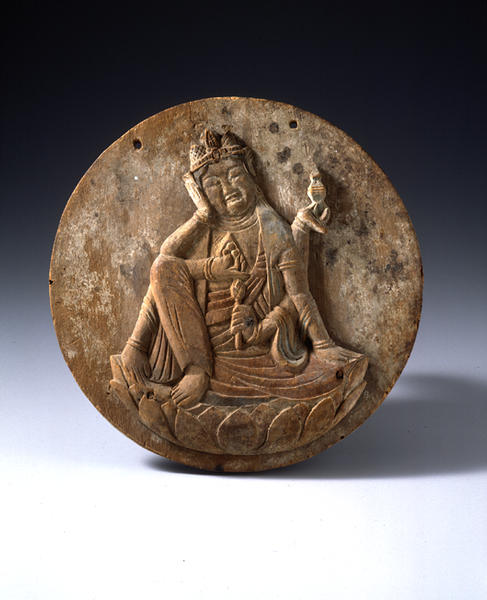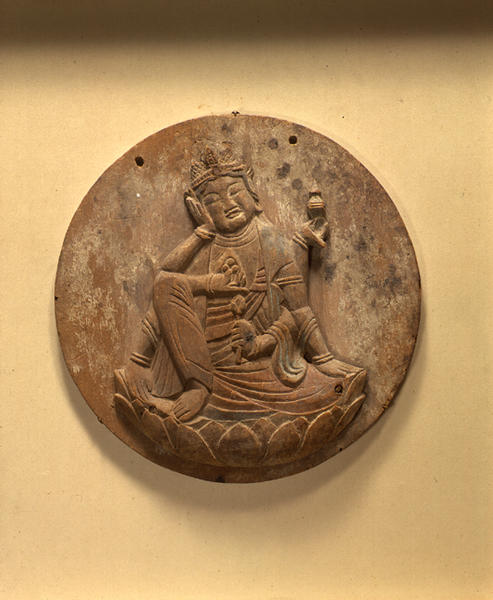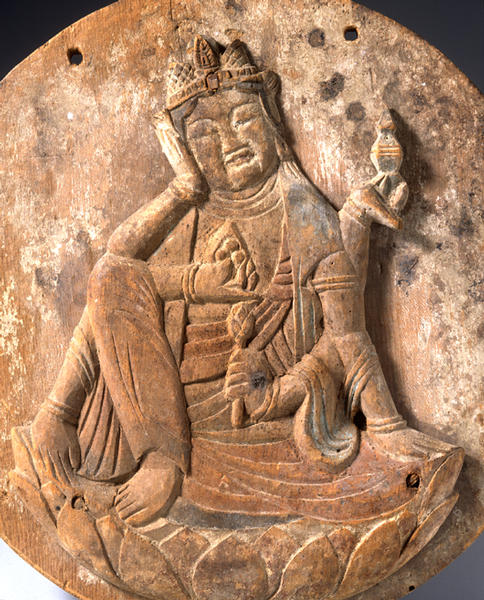如意輪観音懸仏
- 鎌倉時代
- 13-14c
- 木造彩色
- D-20
解説(開館1周年記念展)
丸い板に仏を浮彫で表す懸仏は,そもそも神の依代としての鏡にその姿を描いた鏡像からの変移,あるいは神社の本地仏を表す目的で,月輪の中に描かれた密教図像などを手本としたことから造られたものと推測され,しばしば神社の長押などに掛けられて,見ることの適わぬご神体と信者の仲立ちともなっていたようである。懸仏は平安時代に一般的となり,鎌倉から室町時代にかけて作例が非常に多くなるが,最初は礼拝対象として造立されたものが,やがて人々の願掛けの奉納物として流行したためと思われる。
この作品は胡粉を塗った円形の板に半肉彫の像が3本の木釘で止めてあり,上部には吊り下げるための紐を通した穴が2か所にあいている。像容は右手の第一手を頬にあて,第二手は胸前に宝珠を捧げ,第三手は五指を伸ばして蓮華上に置く。左手第一手も五指を伸ばして蓮華上に安んじ,第二手には塔のような形のものを持つが,茨城県小松寺の木像如意輪観音坐像などに比較すると,宝輪が変化したものかもしれない。左手第三手は胸前の未敷蓮華を持つ。現在,彩色は殆ど失われてしまったが,元は緑青で冠や腕に掛かる天衣と蓮肉が彩色され,化仏や唇,胸前の天衣,裳と蓮弁は赤かったと思われる。髪や目や裳を縁取っている色は,現在黒っぽくしか見えないが,おそらく群青だったのではあるまいか。
この作品は,京都国立博物館所蔵で裏面に「若王子」と書いてある十一面観音懸仏と作風はよく通じており,薄い半肉彫にも関わらず豊かな表情を呈し,平安時代の作に比定される。裏面には「北方如意輪」の墨書がある。
Catalogue Entry
Round plaques showing Buddha in bas-relief perhaps originated from the practice of chasing a deity on a mirror, which was believed to be a dwelling of gods. Alternatively, these plaques might have their origin in painted copies of figures in Esoteric Buddhism, with the entire painting enclosed in a circle; these paintings were intended to symbolize the main object of worship in shrines. These plaques were hung from the front of shrines and served as intermediaries between the faithful and the object of worship which they were not permitted to see. The hanging plaques of Buddha gained popularity during the Heian period (794-1185), a fact that constitutes the reason why there are many works found from the Kamakura (1185-1336) and Muromachi periods (1392-1573). This is attributed to the fact that, although these plaques were originally produced as the object of worship, they became popular later as votive plaques, which were left at a shrine or temple when believers came to pray.
In the present work, a figure of a Kannon, bas-reliefed on wood, is nailed to a round wooden plaque, which is painted white, with three wooden nails. Two holes are visible at the top through which a string for hanging is threaded. The Kannon's first right hand is held at its cheek, the second right hand is at its chest holding a sacred gem, and the third right hand touches the lotus flower with its outstretched fingers. Its first left hand also rests on the lotus flower with stretched fingers, and the second left hand holds up an object that resembles a pagoda. Speculating from the wooden seated Nyoirin Kannon figure in Komatsuji Temple in Ibaraki Prefecture and other similar works, the pagoda may be a transmutation of the sacred wheel. The third left hand holds up a bud of the lotus flower before its chest. Almost all the colors have now been lost, but presumably the crown, the heavenly scarf on its arms, and the lotus flower base were originally decorated in verdigris; and the lips of the Kannon, the scarf at its chest, the skirt, and the lotus petals were probably painted in red. The hair, eyes, and the hem of the skirt now appear dark but they were likely ultramarine in color.
The style of this work is very similar to the eleven-faced Kannon plaque in the Kyoto National Museum that bears an inscription "Nyaku oji" on the back. Despite the fact that the present work is only in half round relief, the image is highly expressive, a stylistic feature which enables dating this plaque to the Heian period. On the back "Hoppo Nyoirin" is written in black ink.


